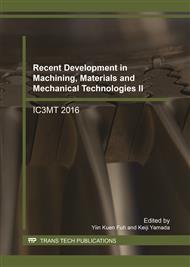p.15
p.21
p.27
p.33
p.39
p.46
p.52
p.58
p.65
On the Formation Mechanisms of Adhering Layer during Machining Metal Material
Abstract:
Built-up Layer (BUL)/Built-up Edge (BUE) formed on the tool surface can be treated as a protective, thermal barrier or lubricant films especially in the extreme severe conditions when machining the metal materials, which can sustain the tool effective and wear resistance. In order to have a thorough understanding of the adhesion effect during machining, experiments have been carried out to investigate the performance and the formation mechanisms of adhering layer on the carbide tool in machining of aluminium alloys A6063, carbon steel S45C and difficult-to-cut hardened steel S45C (H-S45C). The morphology of tool adhered surface was examined by employing Scanning Electron Microscopy (SEM), the dimensions of adhering layer were measured by Laser Scanning Microscopy (LSM) and the elements on the tool were analyzed by Electron Probe Micro Analyser (EPMA), respectively. The atomic-scale cluster adhesive friction model is proposed to explain the tool-chip contact conditions, which considers the nature of the shear strain, shear strain rate and temperature distribution in the secondary deformation zone. The model is a dynamic model and the rate equation approach can be applied to estimate the formation process of adhering layer during machining. Results have shown that the adhering layer will give rise to BUL on the tool rake face and the BUE on the cutting edge and clearance face.
Info:
Periodical:
Pages:
39-45
Citation:
Online since:
August 2017
Authors:
Keywords:
Price:
Сopyright:
© 2017 Trans Tech Publications Ltd. All Rights Reserved
Share:
Citation:


